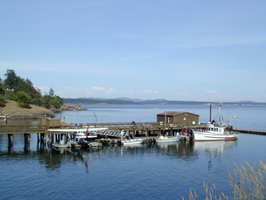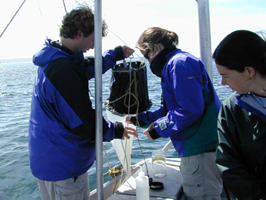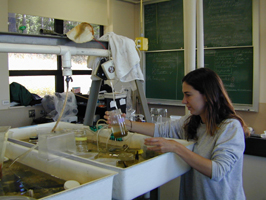Field and
Lab Notebook
A record
of our observations during the project

Wednesday, June
28
Currents, light, food
resource, tidal fluxes--so many different factors influence the types and
numbers of zooplankton found in nearshore waters. We only have a
few days to explore the diversity of forms and lifestyles of marine zooplankton
in the vicinity of San Juan Island, and none of us have much experience
identifying these creatures. So after thoughtful discussion, we decided
to collect from as many places as we could, night and day, and to catalogue
what we find using digital imaging equipment in the lab. We studied
coastal plankton field guides first, to figure out which sized nets (150,300,
and 500 micron mesh) to deploy. We learned how to run the hydraulic
system on a 25 ft aluminum boat, the Auklet, and were checked out on various
safety protocols. Now we're ready to collect plankton!
Thursday, June 29
We towed several different
sized nets from the Auklet this morning, seeking creatures from 150 to
500 microns (0.15 - 0.50 mm) in length. We were not disappointed.
After towing the net at a fairly shallow depth through a series of slicks
(alternating smooth and rough water due to the concentration of organic
material at the surface by ocean currents), we segregated the various tows
to different jars for later exploration. We followed the same protocol
in the evening; once night had fallen around 10 PM, we towed several times
from the Auklet, anticipating catching a different suite of planktonic
life. We look forward to sorting through the samples now stored in
the sea table tomorrow.

Friday, June 30
We started sorting
samples from yesterday in earnest this morning. Even though we'd
inspected the bottles quickly when we set up the bubbling system, we are
continually surprised by the diversity of creatures encountered in the
petri dishes.
A jellyfish-like ctenophore
(see the movie)was lurking near
the bottom of the first daytime tow jar, its ciliated combs moving gently
against the mass of copepods also pressed against the glass surface.
We used a cut-off plastic pipette to transfer the ctenophore to the "black
box", an 6" by 15" plastic aquarium covered on three sides with black tape
and lit from above. Once in the more spacious container, the
globe-shaped creature moved smoothly through the water, its luminescent
combs sparkling with its steady swimming.
Another night-time
find, a sea butterfly, lilted
up and down in its brightly colored internal organs visible against its
nearly translucent, rubbery body. Its form reminded me of a slug
from the nearby forest, though its quick, smooth motion belied any terrestrial
movement. The clione is a Pteropod, a pelagic mollusc, which is found
throughout the northern oceans of the world.
Copepods from the daytime
tow were endless, with many variations on the shrimp like body and bulbous
eyes. These abundant crustaceans, many of which resemble tiny shrimp
or lobsters, darted quickly, making photography difficult. We put
several in alcohol to slow them down, so as to capture them on film.
The night tow yielded an equally abundant set of young crabs, or zoea (see
the movie). With sharp,
defensive spines adorning their heads and a frenetic, seemingly random
swimming pattern, they remind me of battalions of confused soldiers without
a leader.

Saturday, July 1
Though we aerated
our samples from the last day in a flowing seawater table, unfortunately,
they quickly began to rot. So we tossed the jars and did a couple
of vertical tows off the Labs dock.
Sunday, July 2
We night-lighted again
tonight, in search of creatures other than crab zoea. Many of the
young crabs had now developed to the megalopa stage, one step closer to
the benthic lifestyle. They thronged the light, making it difficult
for us to pick out the sinuous, bright orange polychaetes and delicate
gelatinous creatures. A spawning nereid worm, some 25 cm in length,
pulsed along the surface of the water, its powerful legs shining with the
glow of our underwater light. A shrimp attacked it, sparring with
its front legs and shaking the worm violently. The worm slid away
with a powerful motion, and continued to release its sperm at the water's
surface.
Monday, July 3
We are gathering photos of creatures that we've been unable to spot in
our few days of sampling. Researchers from around the lab have donated
pictures of planktonic young of snails, sea stars, sand dollars, and sea
cucumbers. We've started laying out our web page in Netscape,
figuring out how best to share the tens of photos that we've taken in the
last few days. It's very exciting to have something to share, even
after such a brief investigation of the plankton.
Plankton
Home

